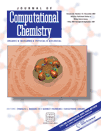Ab initio direct dynamics studies on the reactions of chlorine atom with CH3−nFnCH2OH (n = 1–3)
Abstract
The hydrogen abstraction reactions of Cl atom with a series of fluorinated alcohols, i.e., CH3−nFnCH2OH + Cl (n = 1–3) (R1–R3) have been studied systematically by ab initio direct dynamics method and the canonical variational transition state theory (CVT). The potential energy surface information is calculated at the MP2/6-311G(d,p) level. Energies along the minimum energy paths are improved by a series of single-point calculations at the higher modified GAUSSIAN-2 (G2M) level of theory. Theoretical analysis shows that three kinds of hydrogen atoms can be abstracted from the reactants CH2FCH2OH and CHF2CH2OH, and for CF3CH2OH, two possible pathways are found. The rate constants for each reaction channel are evaluated by CVT with the small-curvature tunneling correction (SCT) over a wide range of temperature from 200 to 2000 K. The calculated CVT/SCT rate constants are in good agreement with the available experimental values for the reactions CHF2CH2OH + Cl and CF3CH2OH + Cl. However, for the reaction CH2FCH2OH + Cl, there is negative temperature dependence below 500 K, which is different from the experimental fitted. It is shown that in the low temperature ranges, the three reactions all proceed predominantly via H-abstraction from the methylene positions, and with the increase of the temperature the H-abstraction channels from the fluorinated-methyl positions should be taken into account, while the H-abstraction channels from the hydroxyl groups are negligible over the whole temperature ranges. Also, the reactivity decreases substantially with fluorine substitution at the methyl position of alcohol. © 2007 Wiley Periodicals, Inc. J Comput Chem, 2007




